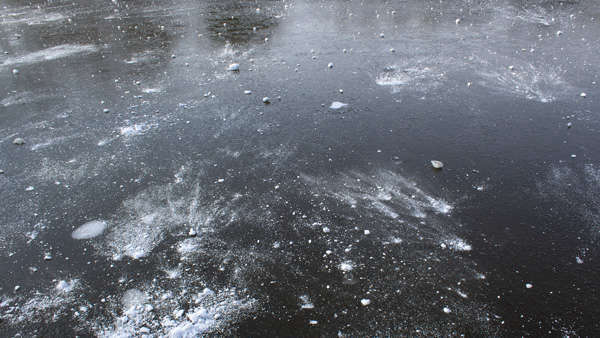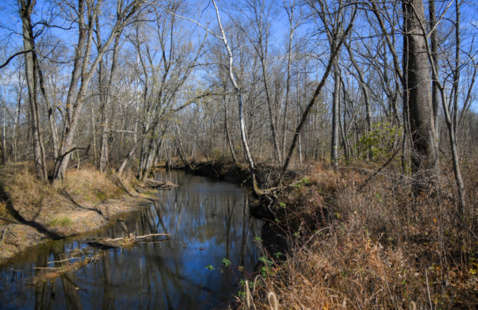
Every winter, thousands of Hoosiers safely enjoy fishing, skating, hiking, or just sliding around on frozen ponds and lakes. And every year, people drown after falling through ice.
Don’t let this happen to you or anyone around you.
Indiana Conservation Officers remind Hoosiers to be careful as they begin to partake in activities such as ice fishing, ice skating, or snowmobiling. Remember to put safety first. Take caution when going on frozen lakes, ponds, rivers, streams, and retention ponds. And watch for others who may venture out on frozen waterways and find themselves in trouble.
Similar to needing to drive differently on snowy versus clear roads, safely having fun on ice may require you to adjust from what you have done in the past. The rule of thumb is to believe all ice is thin ice unless proven otherwise.
Here are a few tips to remember when considering standing on or walking on a frozen body of water:
- Assume no ice is safe ice.
- Test the thickness of the ice with an ice auger. At least 4 inches is recommended for ice fishing; 5 inches is recommended for snowmobiling.
- If you don’t know the thickness of the ice, don’t go on it.
- Wear a life jacket or flotation coat.
- Carry ice picks and rope gear.
- Before going on the ice, leave a note of your whereabouts with a friend or family member.
- Don’t test the thickness of the ice while alone.
Wearing a life jacket is especially important when on ice. If you fall through, a life jacket will keep your head above the water until help arrives.
Remember that a new coating of snow, while perhaps beautiful, can make for treacherous ice conditions. Snow can serve as insulation, causing water to freeze at a slower rate. When snow and rain freeze into ice, it is not as strong as solid, clear ice.
Another potentially dangerous situation is when you see a pet or other animal in distress on the ice. If that happens, do not go after it. Instead, contact local emergency response personnel, who are equipped to make a rescue.
A few more tips:
- Some bodies of water can appear to be frozen solid but still have thin ice in several unexpected areas.
- Avoid flowing water, such as rivers and streams, when covered by a layer of ice.
- Similarly, water surrounded by sand may freeze with inconsistencies in the thickness of the ice.
- Underground springs, wind, waterfowl, and other animals can also keep areas of ice thin.


 Lawrenceville Drive-In to close
Lawrenceville Drive-In to close
 Fiscus receives leadership award
Fiscus receives leadership award
 Fire at old Lawrenceville High School property
Fire at old Lawrenceville High School property
 1956 Pinkstaff tornado the subject of next Historical Society meeting
1956 Pinkstaff tornado the subject of next Historical Society meeting
 Bridgeport city council welcomes new member
Bridgeport city council welcomes new member
 Bailey to continue gubernatorial nomination campaign
Bailey to continue gubernatorial nomination campaign
 Two sentenced to prison in Lawrence County
Two sentenced to prison in Lawrence County
 Illinois State Museum featuring personal Route 66 stories for Mother Road’s 100th anniversary
Illinois State Museum featuring personal Route 66 stories for Mother Road’s 100th anniversary
 Good Samaritan CEO Rob McLin honored with IHA 2025 Distinguished Service Award
Good Samaritan CEO Rob McLin honored with IHA 2025 Distinguished Service Award
 Illinois goes from “F” to“A” on support for survivors of human trafficking
Illinois goes from “F” to“A” on support for survivors of human trafficking
 Carbon Monoxide Awareness Month underway
Carbon Monoxide Awareness Month underway
 IDOH approves Union - Regional hospital merger
IDOH approves Union - Regional hospital merger
 VU announces changes in College of Health Sciences and Human Performance
VU announces changes in College of Health Sciences and Human Performance
 Unit 20 hires new administrator and fills board vacancy
Unit 20 hires new administrator and fills board vacancy
 New IDOC mail policy program protested
New IDOC mail policy program protested
 Eagle Branch District to host annual meeting
Eagle Branch District to host annual meeting
 Niemerg Lawrence County satellite office hours set
Niemerg Lawrence County satellite office hours set
 Select Wings Etc. locations offering free entrée on Veterans Day
Select Wings Etc. locations offering free entrée on Veterans Day
 FSSA statement on SNAP benefits, one week delay
FSSA statement on SNAP benefits, one week delay




